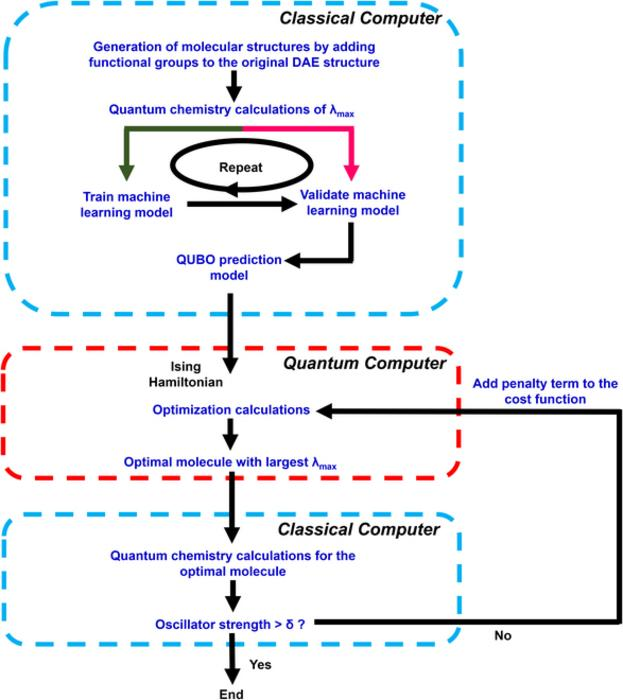Reviewed by Lexie CornerFeb 6 2025
According to a recent study published in the journal Intelligent Computing, researchers created a novel quantum-classical computing scheme for designing photochromic materials and light-sensitive compounds to speed up the discovery of new materials.
 This flowchart illustrates the hybrid quantum-classical approach used to identify the optimal diarylethene (DAE) derivatives with large absorbance wavelengths (λmax) and high oscillator strengths. The process integrates quantum chemistry calculations, machine learning, and quantum optimization to streamline the discovery of photochromic materials. Image Credit: Qi Gao et al.
This flowchart illustrates the hybrid quantum-classical approach used to identify the optimal diarylethene (DAE) derivatives with large absorbance wavelengths (λmax) and high oscillator strengths. The process integrates quantum chemistry calculations, machine learning, and quantum optimization to streamline the discovery of photochromic materials. Image Credit: Qi Gao et al.
The new strategy is based on a computational-basis variational quantum deflation method and builds on the team's earlier study published in the same journal.
The research team applied their methodology to a phytopharmacology case study, screening 4,096 diarylethene derivatives and identifying five candidates with two key properties: high oscillator strengths and large maximum absorbance wavelengths. These properties are critical for photopharmacology applications, such as light-controlled drug delivery.
Photopharmacology is an emerging field that enables targeted drug activation or deactivation using light. Diarylethene derivatives are particularly promising due to their thermal stability and ability to undergo light-induced color changes.
The study began with the generation of molecular structures and quantum chemistry-based property predictions for 384 diarylethene derivatives. These results were used to train a machine learning model to predict properties for a larger set of 4,096 derivatives.
Optimization was performed using a quantum computer, which used an Ising Hamiltonian—a mathematical model describing the system—to identify molecules with the highest maximum absorbance wavelengths. The most promising candidates were then validated through quantum chemistry computations on classical computers to ensure they met criteria for further investigation.
During the quantum optimization, a 12-qubit quantum calculation effectively simulated the ground state and four excited states of the Ising model. This step facilitated the identification of diarylethene derivatives with the highest and next three largest absorbance wavelengths.
Molecular orbital contributions to absorbance were further analyzed using quantum chemistry calculations, guiding the design of new diarylethene derivatives with both strong oscillator strengths and large absorbance wavelengths.
The new approach was validated against results from an exact eigensolver, a computational tool for determining energy levels in Hamiltonian systems. When tested on a quantum simulator, the method demonstrated strong agreement with the eigensolver results. Advanced error suppression and mitigation techniques ensured that the method maintained accuracy comparable to the simulator, even when implemented on real quantum devices.
Recent advances in material discovery have integrated machine learning with quantum chemistry computations to enhance efficiency. While this hybrid approach reduces computational costs compared to conventional methods, challenges remain, including limitations in discrete optimization for large chemical spaces and constraints on training dataset size and quality.
The new quantum-classical approach addresses these challenges, offering a framework for exploring additional functional materials in future research.
Journal Reference:
GAO, Q., et al. (2024) A Quantum-Classical Method Applied to Material Design: Photochromic Materials Optimization for Photopharmacology Applications. Intelligent Computing. doi.org/10.34133/icomputing.0108.